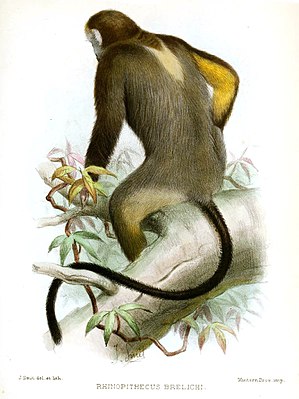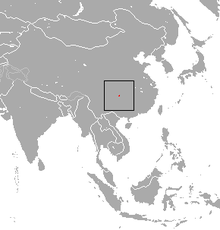Gray blunt nose
| Gray blunt nose | ||||||||||||
|---|---|---|---|---|---|---|---|---|---|---|---|---|

Gray snub nose ( Rhinopithecus brelichi ) |
||||||||||||
| Systematics | ||||||||||||
|
||||||||||||
| Scientific name | ||||||||||||
| Rhinopithecus brelichi | ||||||||||||
| Thomas , 1903 |
The gray snub nose or Guizhou snub nose ( Rhinopithecus brelichi ) is a species of primate from the group of the Schlankaffen (Presbytini).
features
Gray snub noses are relatively colorful primates. The basic color of their fur is gray-brown, a stripe on the top of the head is yellow, as is the chest and the inside of the upper arms. The underside of the back is colored gray. The region around the eyes is hairless and white or light blue. As with all snub- nosed monkeys , the nose is very small and the nostrils protrude forward. At an average of 14 kilograms, males are significantly heavier than females, who weigh around 8 kilograms.
distribution and habitat
Gray snub noses are endemic to China , they only occur in the Fanjing Mountains area in Guizhou Province . Habitat are mountainous conifers - or mixed forests, they live at altitudes between 1500 and 2200 meters. They are relatively cold-tolerant, 5 months a year the temperature can drop below 0 ° C and snow is frequent in winter.
Way of life
These primates are diurnal and arboreal, which means that they can usually be found in trees. There they move on all fours or swinging on the branches. They live in groups of 5 to 10 animals made up of a male, several females and their offspring. There are also groups of pure males, which are 2 to 5 animals smaller. Several groups sometimes join together to form larger associations with up to 400 animals.
They are herbivores, depending on the season they eat leaves, buds, fruits and seeds.
Little is known about reproduction. A single young animal is born in April or May.
threat
The gray snub noses were hunted because they are used in Chinese medicine and their fur was popular. Poaching is still a problem today, but the threat posed by habitat loss due to deforestation is greater. Today these animals are almost only found in the 275 km 2 Fanjing Shan Nature Reserve. Estimates of the total population amount to 800 to 1200 animals, the IUCN lists the species as endangered .
literature
- Thomas Geissmann : Comparative Primatology. Springer-Verlag, Berlin et al. 2003, ISBN 3-540-43645-6 .
Web links
- Rhinopithecus brelichi in the endangered Red List species the IUCN 2006. Posted by: A. Eudey & Members of the Primate Specialist Group, 2000. Retrieved on April 4 of 2008.
- Information on Theprimata.com (English)
- Information on Animalinfo.org (English) with image links
